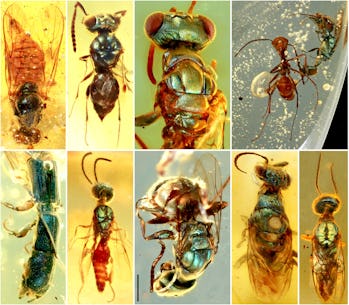Locked in time, ancient remains preserved in amber give scientists important clues into what life was like millions of years ago.
But often, those relics of ancient history become washed-out over the intervening millennia: Colors fade, leaving just a partial view into the past. In a rare twist, paleontologists recently uncovered a set of beautifully preserved insects — still vibrantly colored — from 99 million years ago. The team discovered 35 pieces of amber from a mine in northern Myanmar, which unveiled stunning cuckoo wasps, beetles, and a soldier fly. The brilliantly colored bugs range from metallic bluish-green to purple, each dating back to the mid-Cretaceous period, or the “golden age of dinosaurs.”
 Animals’ colorings give scientists information about their behavior; the theory here is that the spectacular colors may have helped the insects camouflage. The vibrant colors also may have been part of the bugs’ thermoregulation. The findings were published on Tuesday in the journal Proceedings of the Royal Society B.
Animals’ colorings give scientists information about their behavior; the theory here is that the spectacular colors may have helped the insects camouflage. The vibrant colors also may have been part of the bugs’ thermoregulation. The findings were published on Tuesday in the journal Proceedings of the Royal Society B.
 The preserved cuckoo wasps appear metallic blue-green, yellow-green, purple-blue, and green. Beetle specimens are blue and purple, while a single soldier fly shines dark green. “We have seen thousands of amber fossils but the preservation of color in these specimens is extraordinary,” study co-author Huang Diying, a professor at the Nanjing Institute of Geology and Paleontology, said.
The preserved cuckoo wasps appear metallic blue-green, yellow-green, purple-blue, and green. Beetle specimens are blue and purple, while a single soldier fly shines dark green. “We have seen thousands of amber fossils but the preservation of color in these specimens is extraordinary,” study co-author Huang Diying, a professor at the Nanjing Institute of Geology and Paleontology, said.  The benefit of brilliant color — Animals get their colors from three sources: bioluminescence, pigments, and structural colors. The bugs from Myanmar are colored by the structure of their bodies. Tiny bio-photonic structures interfere with visible light, creating the colors we see. These are “the most pure and intense colors in nature,” Diying and his team write. In some ancient samples, the structure of a preserved animal gets distorted over time. That removes their once-shimmering structural colors.
The benefit of brilliant color — Animals get their colors from three sources: bioluminescence, pigments, and structural colors. The bugs from Myanmar are colored by the structure of their bodies. Tiny bio-photonic structures interfere with visible light, creating the colors we see. These are “the most pure and intense colors in nature,” Diying and his team write. In some ancient samples, the structure of a preserved animal gets distorted over time. That removes their once-shimmering structural colors.
The Myanmar bugs, however, were so well-preserved that their colors still shine brightly.  Original vs. altered colors in two cuckoo wasp fossils.NIGPAS Cuckoo wasps still exist today; the well-preserved cuckoo wasps are nearly the same in color as modern wasps. The wasps are parasitic: They lay their eggs in the nests of other bees and wasps. To achieve that, camouflage is essential. It’s reasoned that the wasps’ metallic greenish colors help them blend in with their surroundings and avoid being seen by the animals whose nests they are hijacking — both now and nearly 100 million years ago. But there may be another useful reason for the ancient array of colors.
Original vs. altered colors in two cuckoo wasp fossils.NIGPAS Cuckoo wasps still exist today; the well-preserved cuckoo wasps are nearly the same in color as modern wasps. The wasps are parasitic: They lay their eggs in the nests of other bees and wasps. To achieve that, camouflage is essential. It’s reasoned that the wasps’ metallic greenish colors help them blend in with their surroundings and avoid being seen by the animals whose nests they are hijacking — both now and nearly 100 million years ago. But there may be another useful reason for the ancient array of colors.
“At the moment we also cannot rule out the possibility that the colors played other roles besides camouflage, such as thermoregulation,” lead study author Cai Chenyang, a researcher at the Nanjing Institute of Geology and Paleontology, explains. Abstract: Structural colors, nature’s most pure and intense colors, originate when light is scattered via nanoscale modulations of the refractive index. Original colors in fossils illuminate the ecological interactions among extinct organisms and functional evolution of colors. Here, we report multiple examples of vivid metallic colors in diverse insects from mid-Cretaceous amber. Scanning and transmission electron microscopy revealed a smooth outer surface and five alternating electron-dense and electron-lucent layers in the epicuticle of a fossil wasp, suggesting that multilayer reflectors, the most common biophotonic nanostructure in animals and even plants, are responsible for the exceptional preservation of color in amber fossils. Based on theoretical modeling of the reflectance spectra, a reflective peak of wavelength of 514 nm was calculated, corresponding to the bluish-green color observed under white light. The green to blue structural colors in fossil wasps, beetles and a fly most likely functioned as camouflage, although other functions such as thermoregulation cannot be ruled out. This discovery not only provides critical evidence of evolution of structural colors in arthropods, but also sheds light on the preservation potential of nanostructures of ancient animals through geological time.
Source: siamtoo.com





